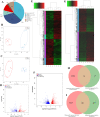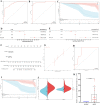Analysis of Immune and Prognostic-Related lncRNA PRKCQ-AS1 for Predicting Prognosis and Regulating Effect in Sepsis
- PMID: 38229689
- PMCID: PMC10790647
- DOI: 10.2147/JIR.S433057
Analysis of Immune and Prognostic-Related lncRNA PRKCQ-AS1 for Predicting Prognosis and Regulating Effect in Sepsis
Abstract
Background: Sepsis was a high mortality and great harm systemic inflammatory response syndrome caused by infection. lncRNAs were potential prognostic marker and therapeutic target. Therefore, we expect to screen and analyze lncRNAs with potential prognostic markers in sepsis.
Methods: Transcriptome sequencing and limma was used to screen dysregulated RNAs. Key RNAs were screened by correlation analysis, lncRNA-mRNA co-expression and weighted gene co-expression network analysis. Immune infiltration, gene set enrichment analysis and gene set variation analysis were used to analyze the immune correlation. Kaplan-Meier curve, receiver operator characteristic curve, Cox regression analysis and nomogram were used to analyze the correlation between key RNAs and prognosis. Sepsis model was established by lipopolysaccharide-induced HUVECs injury, and then cell viability and migration ability were detected by cell counting kit-8 and wound healing assay. The levels of apoptosis-related proteins and inflammatory cytokines were detected by RT-qPCR and Western blot. Reactive Oxygen Species and superoxide dismutase were detected by commercial kit.
Results: Fourteen key differentially expressed lncRNAs and 663 key differentially expressed genes were obtained. And these lncRNAs were closely related to immune cells, especially T cell activation, immune response and inflammation. Subsequently, Subsequently, lncRNA PRKCQ-AS1 was identified as the regulator for further investigation in sepsis. RT-qPCR results showed that PRKCQ-AS1 expression was up-regulated in clinical samples and sepsis model cells, which was an independent prognostic factor in sepsis patients. Immune correlation analysis showed that PRKCQ-AS1 was involved in the immune response and inflammatory process of sepsis. Cell function tests confirmed that PRKCQ-AS1 could inhibit sepsis model cells viability and promote cell apoptosis, inflammatory damage and oxidative stress.
Conclusion: We constructed immune-related lncRNA-mRNA regulatory networks in the progression of sepsis and confirmed that PRKCQ-AS1 is an important prognostic factor affecting the progression of sepsis and is involved in immune response.
Keywords: PRKCQ-AS1; immune-related lncRNA; lncRNA-mRNA; prognosis and progress; sepsis.
© 2024 Ding et al.
Conflict of interest statement
The authors declare that they do not have any potential conflicts of interest in this work.
Figures








Similar articles
-
Using lncRNA Sequencing to Reveal a Putative lncRNA-mRNA Correlation Network and the Potential Role of PCBP1-AS1 in the Pathogenesis of Cervical Cancer.Front Oncol. 2021 Mar 23;11:634732. doi: 10.3389/fonc.2021.634732. eCollection 2021. Front Oncol. 2021. PMID: 33833992 Free PMC article.
-
Identification of PRKCQ-AS1 as a Keratinocyte-Derived Exosomal lncRNA That Promotes Th17 Differentiation and IL-17 secretion in Psoriasis Through Bioinformatics, Machine Learning Algorithms, and Cell Experiments.J Inflamm Res. 2025 May 22;18:6557-6582. doi: 10.2147/JIR.S521553. eCollection 2025. J Inflamm Res. 2025. PMID: 40433053 Free PMC article.
-
Identification of immune-related lncRNA in sepsis by construction of ceRNA network and integrating bioinformatic analysis.BMC Genomics. 2023 Aug 24;24(1):484. doi: 10.1186/s12864-023-09535-7. BMC Genomics. 2023. PMID: 37620751 Free PMC article.
-
LncRNA PRKCQ-AS1 regulates paclitaxel resistance in triple-negative breast cancer cells through miR-361-5p/PIK3C3 mediated autophagy.Clin Exp Pharmacol Physiol. 2023 Jun;50(6):431-442. doi: 10.1111/1440-1681.13758. Epub 2023 Mar 14. Clin Exp Pharmacol Physiol. 2023. PMID: 36732923
-
Identification of MFI2-AS1, a Novel Pivotal lncRNA for Prognosis of Stage III/IV Colorectal Cancer.Dig Dis Sci. 2020 Dec;65(12):3538-3550. doi: 10.1007/s10620-020-06064-1. Epub 2020 Jan 20. Dig Dis Sci. 2020. PMID: 31960204 Review.
Cited by
-
Diagnostic and Predictive Value of LncRNA MCM3AP-AS1 in Sepsis and Its Regulatory Role in Sepsis-Induced Myocardial Dysfunction.Cardiovasc Toxicol. 2024 Oct;24(10):1125-1138. doi: 10.1007/s12012-024-09903-z. Epub 2024 Jul 31. Cardiovasc Toxicol. 2024. PMID: 39085530
-
Clinical significance and biological function of PRKCQ-AS1/miR-582-3p expression in LUAD.Hereditas. 2025 Jul 1;162(1):116. doi: 10.1186/s41065-025-00482-9. Hereditas. 2025. PMID: 40597380 Free PMC article.
-
LncRNA CYP1B1-AS1 as a clinical biomarker exacerbates sepsis inflammatory response via targeting miR- 18a- 5p.BMC Immunol. 2025 Apr 16;26(1):32. doi: 10.1186/s12865-025-00712-9. BMC Immunol. 2025. PMID: 40234801 Free PMC article.
References
-
- Gauer R, Forbes D, Boyer N. Sepsis: diagnosis and management. Am Fam Physician. 2020;101(7):409–418. - PubMed
LinkOut - more resources
Full Text Sources

